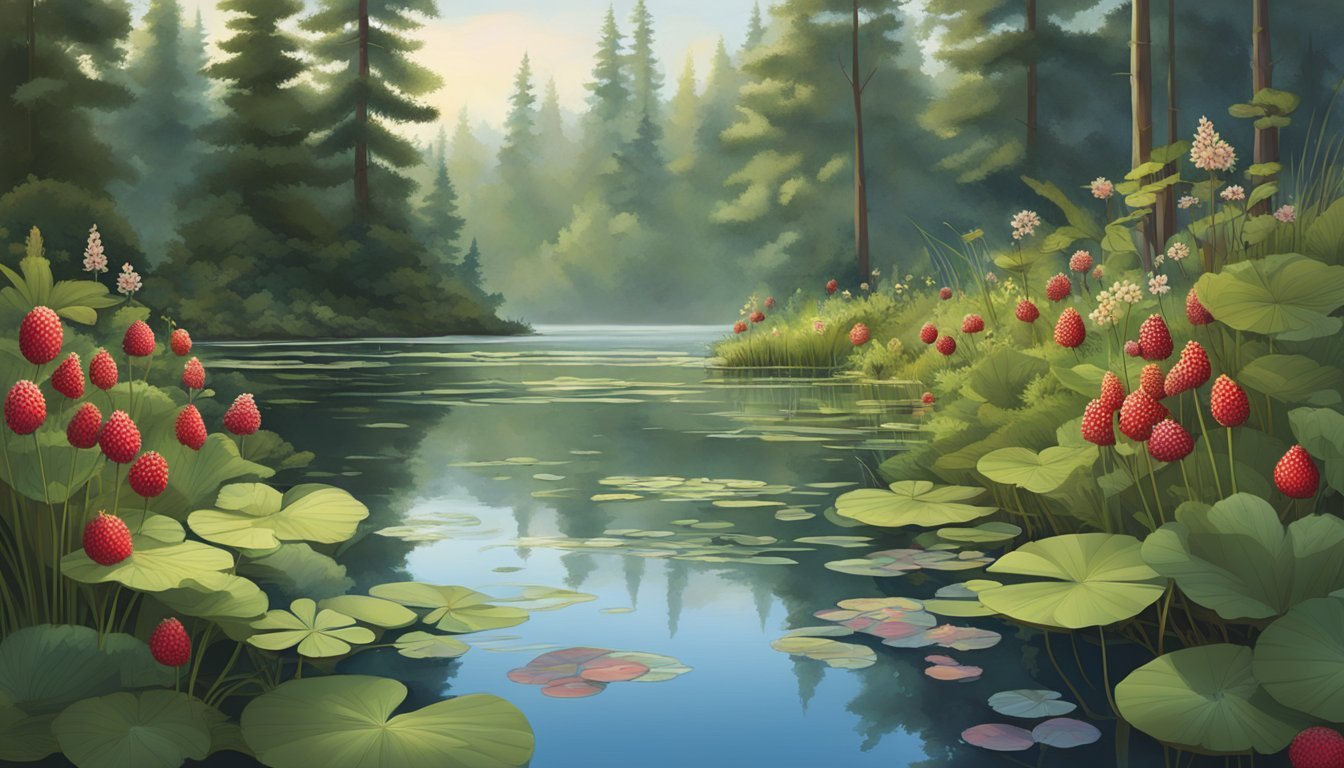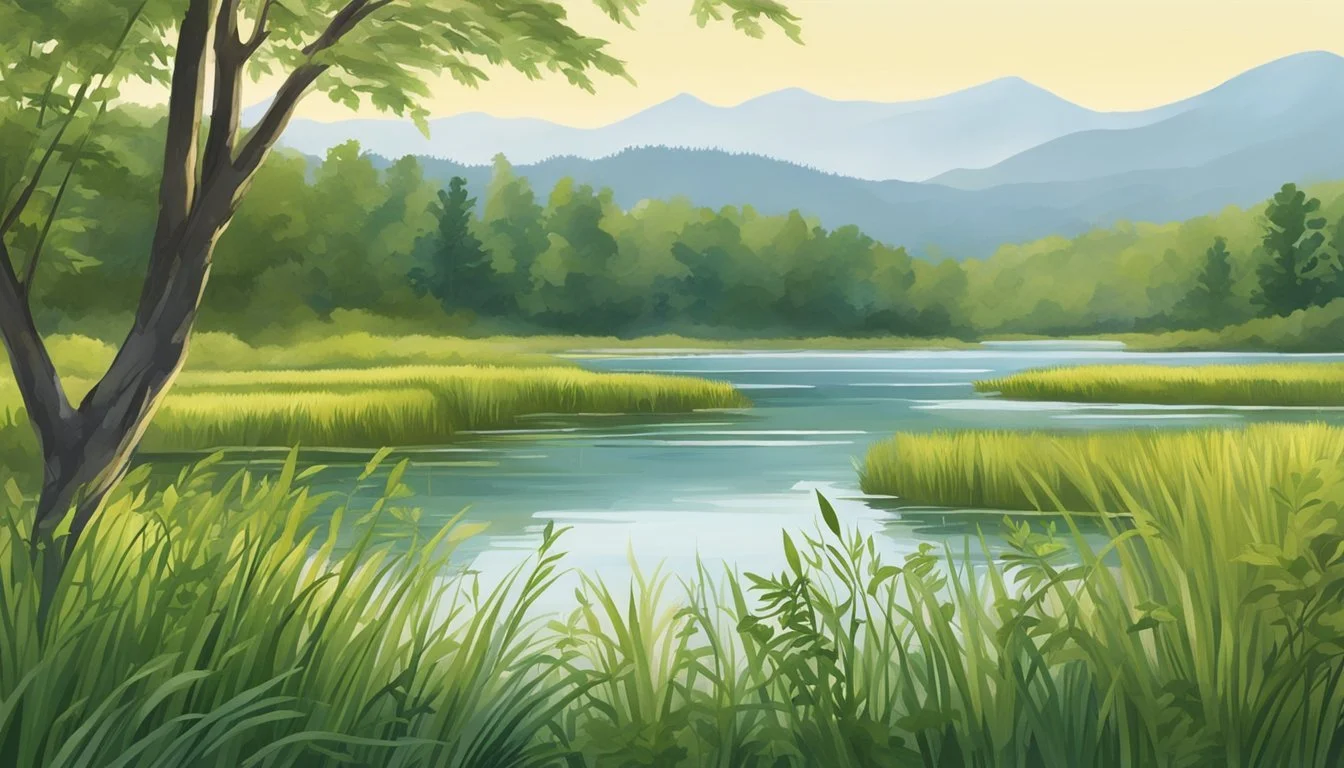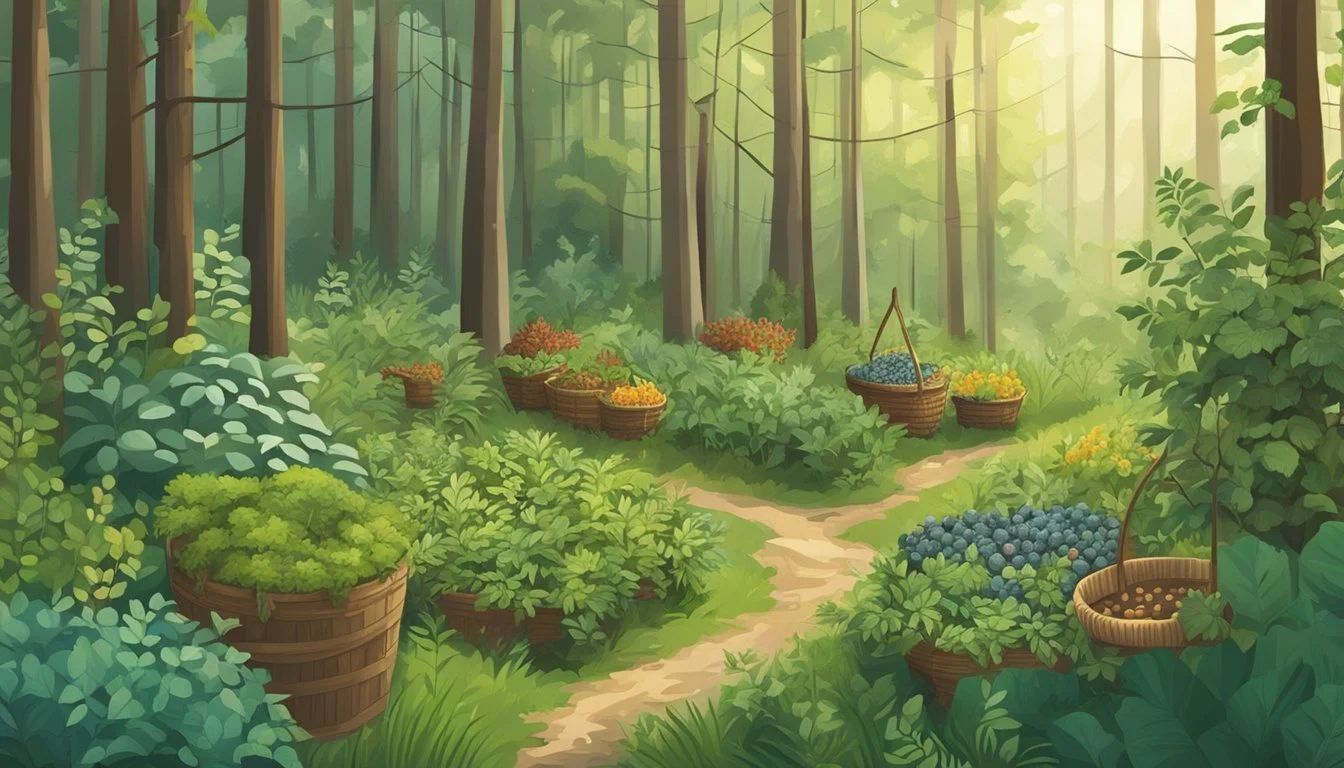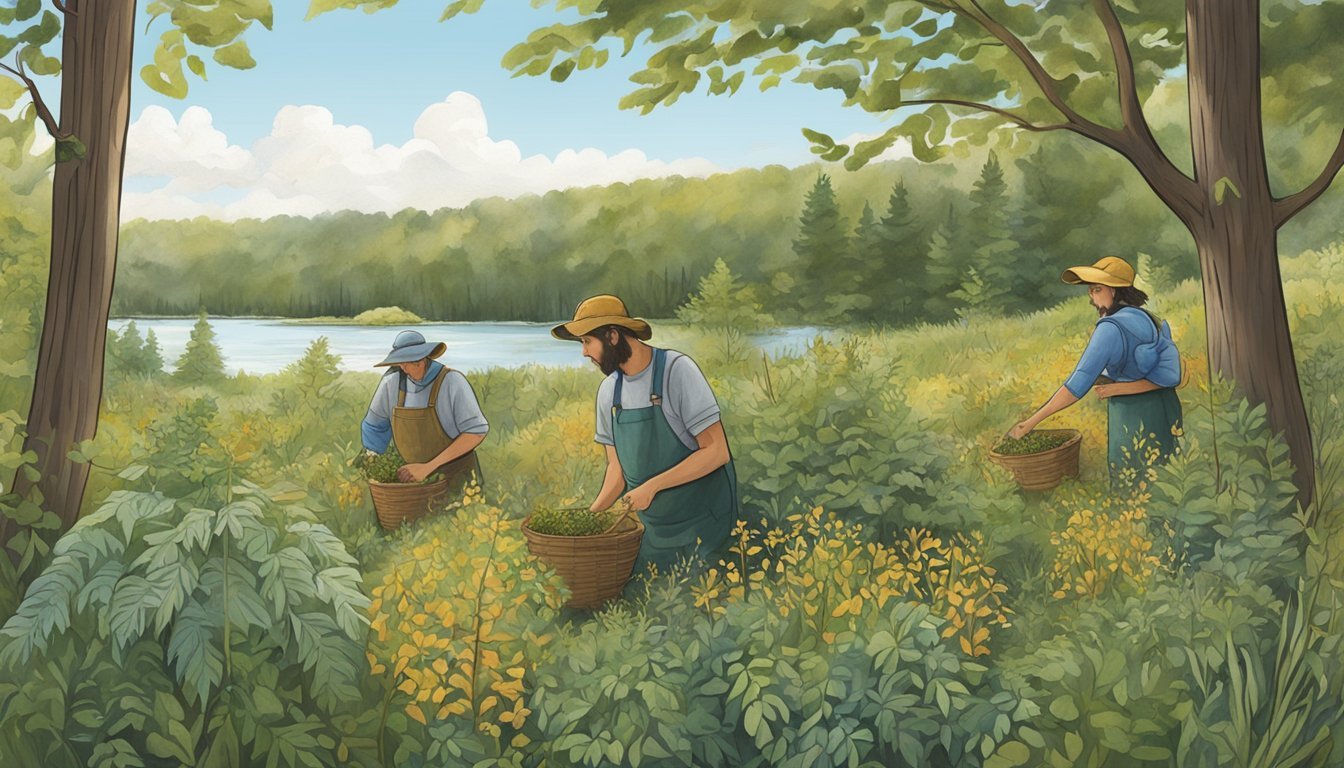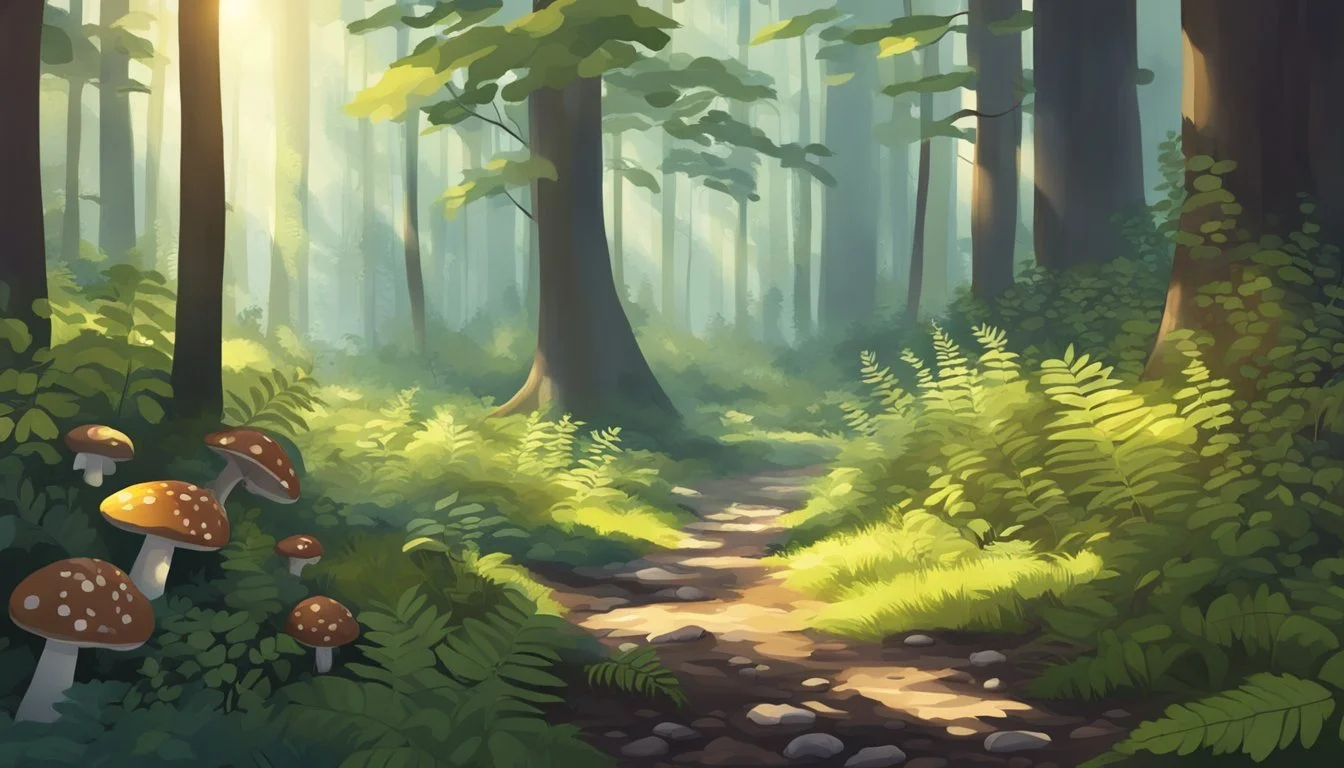Great Lakes Native Edible Plants
A Forager's Guide
Discovering the native edible plants of the Great Lakes region not only deepens one's connection to the environment but also provides sustainable and nutritious food options. This region's diverse climates and ecosystems—from forested areas to lakeshores—support a wide variety of plants that have been utilized by indigenous people and early settlers for centuries. Foraging for wild edibles such as wild blueberries, chokecherries, and black raspberries can be a rewarding experience, offering unique flavors and health benefits.
Integrating these native plants into gardens or small-scale agriculture can significantly bolster food security and biodiversity. Gardens filled with native species not only supply an abundance of healthy produce but also attract pollinators and beneficial insects, enhancing the overall ecosystem. This practice helps in preserving local flora and fauna, contributing positively to environmental stewardship.
Exploring native edible plants in the Great Lakes region is an invitation to reconnect with nature and participate in sustainable living. Understanding which plants are suitable for cultivation and foraging can transform one's approach to both gardening and diet, fostering a lifestyle that supports both personal health and ecological balance.
Great Lakes Region Overview
The Great Lakes Region is a diverse and ecologically rich area spanning parts of the United States and Canada. It encompasses the states of Michigan, Minnesota, and Wisconsin, and extends into Ontario in Canada.
Geography and Climate
This region is known for its vast freshwater lakes, including Lakes Superior, Michigan, Huron, Erie, and Ontario. These lakes create unique microclimates that support a variety of ecosystems.
Ecological Diversity
The Great Lakes Region houses numerous forests, wetlands, and prairies. This variety of habitats allows for a rich biodiversity, particularly in terms of plant life.
Human Impact
Human activity has significantly shaped the region. Agricultural practices, urban development, and conservation efforts all play critical roles in the region's current landscape.
Flora and Fauna
The region supports a wide array of native plants and animals. Notable native edible plants include wild blueberries, chokecherries, and black raspberries.
Wild Blueberries can be found in sandy or rocky areas.
Chokecherries often grow in moist areas like stream banks.
Black Raspberries are common in wooded or semi-open habitats.
Conservation Efforts
Conservation in the Great Lakes Region focuses on preserving native plants and restoring degraded ecosystems. These efforts help maintain biodiversity and promote sustainable land use.
By maintaining a balance between human activity and natural habitats, the Great Lakes Region continues to thrive as a biodiverse and ecologically important area.
Understanding Native Edible Plants
Native edible plants in the Great Lakes region offer historical significance, impressive nutritional value, and vital ecological roles. They enhance biodiversity and support the local ecosystem.
Historical Significance
Native plants have been deeply rooted in the cultural and dietary practices of indigenous peoples. For centuries, tribes located around the Great Lakes, such as the Ojibwe and Potawatomi, relied on these plants for sustenance.
Wild rice, for example, was not only a staple food but also a trade commodity. Pawpaw fruits and elderberries were used in traditional recipes. The historical cultivation of these plants showcases the profound knowledge of indigenous communities regarding local ecology and conservation practices.
Nutritional Value
The nutritional benefits of native plants are vast. Many of these plants are rich in vitamins, minerals, and antioxidants, making them excellent food sources. For instance, American cranberry offers ample amounts of vitamin C and dietary fiber.
Pawpaw, often termed the 'poor man's banana,' is high in protein and low in fat. These plants provide a range of nutrients necessary for balanced diets. Their incorporation into modern diets can offer a naturally nutritious alternative to processed foods.
Ecological Role
Native plants play a crucial role in maintaining healthy ecosystems. They support numerous insects and wildlife, promoting biodiversity. Plants like the American chestnut and wild leeks contribute to soil health through nitrogen fixation and organic matter deposition.
These plants are adapted to local conditions, requiring fewer resources and less intensive care compared to non-native species. By sustaining local flora, they help in conservation efforts, ensuring resilient ecosystems capable of enduring environmental changes. Consequently, they support the overall health of the Great Lakes region’s local ecology.
Foraging Essentials
Understanding how to forage responsibly ensures a plentiful, safe, and ethical experience. It's essential to consider timing, safety practices, as well as legal and ethical guidelines to protect both foragers and the environment.
Seasonality and Timing
Knowing when to forage is crucial. Many native plants in the Great Lakes region have specific seasons. For example, wild leeks appear in early spring, while berries like blueberries and black raspberries are available in mid to late summer.
Each plant species thrives in particular conditions. Awareness of these seasonal cycles ensures successful foraging and helps avoid over-harvesting. Always research the optimal time to forage specific plants and adapt to local climatic conditions that might affect growth cycles.
Foraging Safety
Safety is paramount in foraging. Proper identification of plants is critical, as many can easily be mistaken for toxic lookalikes. For example, wild carrots resemble poison hemlock. Use reliable field guides or apps and, when in doubt, consult experienced foragers.
Good hygiene practices should also be observed. Wash all foraged items thoroughly. Store harvested plants properly to avoid contamination.
Legal and Ethical Considerations
Foraging in the United States is regulated by a variety of laws. It is important to know the rules of public lands and obtain necessary permits if required. Private lands necessitate permission from landowners.
Ethical foraging means harvesting sustainably. Take only what is needed and leave enough for wildlife and future growth. Avoid damaging the habitat and educate oneself about endangered species to prevent harm.
Plant Identification Techniques
Identifying native edible plants in the Great Lakes region involves recognizing various plant characteristics. Paying close attention to leaves, flowers, and fruits can help distinguish different species.
Leaves can vary greatly among plants. Shape, size, color, and venation patterns are key features. For example, the heart-shaped leaves of wild violets differ from the serrated edges of wild raspberries.
Flowers also serve as important identifiers. Observe the number of petals, colors, and arrangement. Dandelions, with their bright yellow single flower, contrast sharply with the clustered purple flowers of New England aster.
When examining trees and shrubs, bark texture and growth habits provide clues. Birch trees have distinctive white, peeling bark, while sumac shrubs display fuzzy red fruit clusters.
Table: Edible Plant Features
Plant Type Key Identification Features Herbs Leaf shape, flower color, stem texture Trees Bark type, leaf arrangement, fruit type Shrubs Branch formation, leaf color, berry shape Vines Leaf pattern, climbing habit, fruit clusters
Checklist for Identification
Observe leaf structure: Note size, edge shape, and vein patterns.
Inspect flowers: Count petals, check color, and arrangement.
Examine bark: Look for texture and color differences.
Assess fruit: Identify by shape, size, and taste (carefully, and only if known to be safe).
Plant identification requires careful examination and sometimes a reliable guidebook or expert confirmation. With practice, recognizing these features becomes second nature. This skill enhances the appreciation and responsible foraging of native edible plants.
Key Habitats and Ecosystems
The Great Lakes region is home to a variety of habitats where native edible plants thrive. These include forests, woodlands, wetlands, grasslands, streams, and fields. Each habitat offers a unique combination of resources and conditions that support different types of edible flora.
Forests and Woodlands
Forests and woodlands in the Great Lakes region provide a rich environment for many native edible plants. Wild Leek (Allium tricoccum), often found in deciduous forests, is prized for its pungent bulbs and leaves. American Ginseng (Panax quinquefolius), a valuable medicinal plant, also thrives in these shaded, nutrient-rich soils.
Birch trees, common in these areas, yield edible sap used to make birch syrup. The understory typically supports berry-producing shrubs, such as Blueberries (Vaccinium spp.) and Wild Raspberries (Rubus idaeus). These plants benefit from the moist, well-drained soils and the partially shaded canopy provided by deciduous and coniferous trees.
Wetlands and Grasslands
Wetlands and grasslands are vital ecosystems that support a diverse array of native edible plants. Wetlands, characterized by their saturated soils, are ideal for Cattails (Typha latifolia), whose roots, shoots, and pollen are all edible. Watercress (Nasturtium officinale) thrives in slow-moving streams within wetlands, offering peppery leaves for foragers.
Grasslands, with their open, sunny environments, are perfect for Wild Strawberries (Fragaria virginiana) and Milkweed (Asclepias syriaca). Both plants are important food sources not only for humans but also for pollinators. Grasslands provide nutrient-rich soil that supports these plants, contributing to the ecosystem's biodiversity.
Streams and Fields
Streams and fields present a dynamic environment for various edible plants. Along streams, Ostrich Ferns (Matteuccia struthiopteris) offer fiddleheads, a spring delicacy. The edges of streams provide moist habitats perfect for Jewelweed (Impatiens capensis), known for its edible shoots and leaves.
Fields, often characterized by well-drained soils and exposure to full sunlight, support plants like Jerusalem Artichoke (Helianthus tuberosus), valued for its edible tubers. Additionally, Dandelions (Taraxacum officinale), ubiquitous in fields throughout the region, provide nutrient-rich greens and roots.
These habitats contribute significantly to the biodiversity and sustainability of the Great Lakes region, supporting numerous edible species.
Popular Native Edibles
The Great Lakes region is host to a diverse range of native edible plants, offering various berries, leafy greens, nuts, roots, and fungi that can be foraged or cultivated. These native species not only provide nutritious food options but also support local ecosystems and biodiversity.
Berries and Fruits
Native berries in the Great Lakes region include blueberries, strawberries, and the distinctive American cranberry. Blueberries thrive in acidic soils and are rich in antioxidants, making them a healthy choice for foragers. Wild strawberries grow in sunny, well-drained areas and are smaller but more flavorful than their cultivated counterparts. The American cranberry prefers moist, acidic bogs and requires consistent soil moisture, making it a unique but rewarding native fruit.
Leafy Greens and Vegetables
Leafy greens and vegetables such as wild leeks (Allium tricoccum) are abundant in the region's forests. Wild leeks, also known as ramps, have a strong garlic-onion flavor and grow in shaded, moist environments during the spring. Fiddleheads, the young, coiled fronds of ferns, are another sought-after native vegetable. Harvested in the early spring, they must be cooked thoroughly to remove any toxins and are often compared to asparagus in taste and texture.
Nuts and Seeds
The Great Lakes area features a variety of edible nuts, including black walnuts and hickory nuts. Black walnuts are encased in a hard shell and are known for their rich, earthy flavor. They require effort to harvest but are highly nutritious. Hickory nuts come from several species of hickory trees and have a slightly sweeter taste. Both types of nuts can be used in baking or as snacks.
Roots and Tubers
Root vegetables like wild carrots (Daucus carota) and Jerusalem artichokes (Helianthus tuberosus) are common in the region. Wild carrots, when young, can be used similarly to their cultivated relatives, though they need proper identification to avoid confusion with toxic plants. Jerusalem artichokes, also known as sunchokes, produce edible tubers that are nutty and crisp. They can be roasted, sautéed, or eaten raw in salads.
Fungi
Among the fungi, morels stand out as a prized find for foragers due to their unique honeycomb appearance and savory flavor. These mushrooms grow in well-drained, forested areas during the spring. Chanterelles are another popular edible mushroom, recognized by their yellow-orange funnel-shaped bodies. Both morels and chanterelles add a gourmet touch to various recipes but should always be properly identified to avoid toxic look-alikes.
Plant Profiles
The Great Lakes region hosts a variety of native edible plants that not only contribute to biodiversity but also offer significant culinary value. Key species include the Wild Leek, Common Milkweed, Ostrich Fern, and Stinging Nettle, each providing unique benefits and uses.
Wild Leek (Allium tricoccum)
Wild Leek, also known as ramp, is a perennial plant prized for its garlic-like flavor. It thrives in rich, moist, deciduous forests across the Great Lakes region. Harvested in early spring, both the leaves and bulbs are edible. The leaves are broad and green, while the bulbs are small and white. Ramps are often foraged and can be used in various dishes, such as soups, salads, and pesto. Due to overharvesting, sustainable foraging is crucial.
Common Milkweed (Asclepias syriaca)
Common Milkweed is a versatile plant that grows in meadows, fields, and along roadsides. Young shoots, leaves, flower buds, and immature pods are edible when properly prepared. The plant contains a toxic latex that must be removed by boiling. Once prepared, Milkweed can be used in stir-fries, soups, and as a vegetable side dish. Besides its culinary use, it supports monarch butterflies by serving as a host plant for their larvae.
Ostrich Fern (Matteuccia struthiopteris)
Ostrich Fern, recognized by its gracefully arching fronds, is well-known for its edible fiddleheads. The fiddleheads are harvested in early spring before the frond unfurls. They have a unique, tender taste similar to asparagus or green beans. It is important to cook them thoroughly to remove any potential toxins. Ostrich Fern prefers moist, shaded environments, often growing along stream banks and in forested wetlands.
Stinging Nettle (Urtica dioica)
Stinging Nettle, identifiable by its serrated leaves and stinging hairs, is a nutrient-dense plant that becomes safe to eat once cooked. It is rich in vitamins A, C, and K, as well as iron and calcium. The plant is typically found in moist, nitrogen-rich soils. Nettle leaves can be harvested in spring and used to make soups, teas, and pesto. Cooking neutralizes the sting and renders the leaves tender and flavorful. This plant is valuable not only for its nutritional content but also for its role in promoting soil health and biodiversity.
Sustainable Harvesting Practices
Sustainable harvesting practices are crucial for maintaining the health of ecosystems and biodiversity. When foraging, always prioritize environmental conservation to ensure that plant and animal populations remain robust for future generations.
Follow these guidelines for sustainable harvesting:
Limit Harvesting: Take only what you need, and avoid overharvesting any single species.
Selectively Pick: Harvest plants in a way that allows them to continue growing and reproducing. For instance, only pick mature plants and leave younger ones to mature.
Rotate Foraging Sites: Avoid repeatedly harvesting from the same location. This practice helps maintain plant populations and reduces impact on specific areas.
Ethical considerations:
Respect Protected Areas: Ensure you are not foraging in protected areas or private property without permission.
Know the Laws: Familiarize yourself with local regulations and guidelines related to foraging and plant harvesting.
Indigenous Knowledge: Respect and integrate traditional foraging knowledge, which often includes sustainable practices passed down through generations.
Promote biodiversity and conservation:
Enhance Plant Diversity: By practicing diverse foraging, you help promote a wider variety of species, aiding in the overall health of the ecosystem.
Leave No Trace: Minimize your footprint by not disturbing the surrounding environment more than necessary.
Avoid Harmful Plants: Be aware of and avoid harvesting invasive species, which can harm the local ecosystems.
By adhering to these sustainable harvesting practices, foragers contribute positively to their environments, ensuring the continued availability of wild edible and medicinal plants.
Culinary Applications
Culinary uses of Great Lakes native edible plants range from simple raw preparations to intricate cooked dishes, with a focus on preserving the natural flavors and nutritional value. Techniques vary widely, including boiling, baking, and fermenting.
Preparation and Cooking
Preparation of native edible plants often starts with proper cleaning. Wild berries like blueberries and black raspberries should be rinsed gently. Chokecherries need to be pitted and can be boiled to extract juice for syrups or fermented for beverages.
Wild leeks, also known as ramps, can be sautéed, incorporated into risottos, or used in soups. Staghorn sumac offers a tart flavor, often brewed into tea or infused into various dishes for a lemony tang.
When working with root vegetables or greens, boiling or steaming helps soften tough fibers. Trailing blackberries offer flexibility; they can be enjoyed fresh, dried, or turned into jam. Salmonberries also work well in sweet applications.
Recipes and Uses
Recipes featuring these plants enhance local and seasonal eating. A traditional preparation might involve wild leek soup, combining sautéed leeks with potatoes and broth. Berries like black raspberries and chokecherries can be turned into jams or jellies, ideal for spreading on toast or incorporating into desserts.
Sumac lemonade is a refreshing twist using staghorn sumac, boiling the berries to extract their flavor. Trailing blackberries feature in pies, crumbles, or as simple fresh snacks. For a savory option, foraged greens can be used in salads, offering a unique taste profile with added nutritional benefits.
Using native plants like these not only diversifies meals but also highlights the rich, local biodiversity of the Great Lakes region.
Protection and Preservation
Efforts to protect and preserve native edible plants in the Great Lakes region focus on conservation measures and controlling invasive species that threaten local ecosystems. This ensures biodiversity and the health of the natural environments.
Conservation Efforts
Various organizations and government agencies are committed to conserving native plants. They focus on habitat protection, restoration projects, and public education. For instance, habitat restoration involves replanting native species in degraded areas, which helps re-establish natural plant communities and supports wildlife.
Public education plays a crucial role in these efforts. By informing local communities about the importance of native plants, conservationists encourage practices that support these species. Additionally, initiatives like seed banks help preserve genetic diversity and ensure a future supply of native plants.
Protected areas and reserves are also essential. These designated sites prevent habitat destruction and provide safe spaces for native plants to thrive. They also serve as research areas to study native plant ecology and develop better conservation strategies.
Invasive Species Management
Invasive species pose significant threats to native plants by outcompeting them for resources. Effective management involves several strategies tailored to specific invaders and ecosystems.
Early detection and rapid response (EDRR) is crucial. Monitoring programs help detect invasive species early, making it easier to control or eradicate them before they become widespread. Once an invasive species is identified, physical removal or the use of herbicides might be employed, considering the ecological impact.
Biological control introduces natural predators or pathogens to control invasive populations. This method requires careful assessment to avoid unintended consequences on native species and ecosystems. Community involvement is also vital. Volunteer programs often assist with removing invasive species, contributing to larger management efforts.
Regulation ensures that new invasive species don't enter these ecosystems. This includes stringent checks on imported plants and soil, as well as public awareness campaigns about the dangers of invasives. Proper enforcement of these regulations is essential to protect native edible plant populations.
Foraging In Michigan
Foraging in Michigan offers a unique blend of natural bounty from the Great Lakes region. The state's varied ecosystems, from northern forests to southern plains, provide diverse foraging opportunities.
Michigan's Native Edibles include mushrooms like morels, berries such as blueberries and blackberries, and nuts like hickory and acorns.
Edible Plants:
Morels
Blueberries
Blackberries
Hickory nuts
Acorns
Foraging Venues: Michigan's state parks and national lakeshores are prime spots. Popular sites include the Sleeping Bear Dunes National Lakeshore and the wilderness regions of the Upper Peninsula.
Resources for Foragers: Classes and tours led by experts like Rachel Mifsud of "Will Forage for Food" offer guidance. These sessions focus on plant identification, sustainable harvesting, and cooking techniques.
Safety and Regulations: Foragers must learn what is safe to harvest. Identifying plants correctly is essential to avoid toxic species. Legal considerations involve knowing what can be collected and what must be preserved to protect rare species.
Benefits of Foraging: Foraging not only connects people to their natural heritage but also promotes sustainable food practices. The abundance of flora in Michigan's diverse habitats supports a rich array of edible plants suitable for foraging.
Challenges and Considerations for Foragers
Respecting the environment while foraging in the Great Lakes region involves understanding the unique impacts of climate, habitat loss, and pollution on native edible plants.
Climate Impact
Climate variability affects the availability and growth of native plants. Warmer temperatures can extend the growing season for some species but may adversely affect others. Seasonal changes also play a significant role; foragers must be aware of peak times for plant viability.
Increased occurrences of droughts and floods alter ecosystems, leading to stressful conditions for both plants and foragers. Storms and temperature extremes can disrupt plant cycles, making it harder to predict harvest times.
Habitat Loss
Urbanization and deforestation dramatically reduce native plant habitats. As cities expand, wild spaces shrink, leading to fewer areas where native plants can thrive. This loss reduces the availability of foraging sites.
Agricultural development also contributes to habitat destruction. Large-scale farming often encroaches on natural ecosystems, displacing native flora. Foragers need to be aware of protected areas and seek permits if required, to respect conservation efforts.
Pollution
Pollution poses a serious threat to wild edible plants. Contaminated soils from industrial activities can result in toxic uptake by plants, rendering them unsafe to eat. It’s crucial to avoid areas near factories or heavy traffic where pollutants are more likely.
Water pollution affects wetland plants and those growing near contaminated water bodies. Understanding the sources of pollution in a region helps foragers make safe choices about where to harvest. Regularly updated environmental reports are valuable resources for identifying safe foraging zones.
Outdoor Safety and Navigation
When exploring the wilderness of the Great Lakes region, safety is paramount. Proper preparation can make outdoor adventures safe and enjoyable.
Safety Essentials:
First Aid Kit: Always carry a basic first aid kit.
Hydration: Bring ample water to stay hydrated.
Clothing: Dress in layers for unpredictable weather.
Navigating the diverse landscape of the Great Lakes, from woodlands to open fields, requires reliable tools and skills.
Navigation Tools:
Map and Compass: Traditional, reliable tools that do not rely on batteries.
GPS Device: Useful but should not replace basic navigation skills.
Trail Markers: Follow marked trails to avoid getting lost.
National and State Parks:
The United States boasts numerous parks with clearly marked paths. Sleeping Bear Dunes National Lakeshore and Upper Peninsula’s cedar swamps are popular locations with marked routes.
Personal Safety:
Buddy System: Hike with a partner whenever possible.
Check Weather Conditions: Weather can change rapidly, especially in the woodlands.
Inform Others: Always let someone know your route and expected return time.
Wildlife Awareness:
Respect Wildlife: Keep a safe distance from animals.
Food Storage: Properly store food to avoid attracting bears and other wildlife.
Implementing these safety and navigation practices ensures a secure and enjoyable experience while foraging for native edible plants in the Great Lakes region.
Glossary of Terms
Plant Species: Refers to different kinds of plants, each with unique characteristics and names. In the Great Lakes region, examples include wild blueberries and black raspberries.
Flowers: The reproductive structure of flowering plants. Native edible plants often have distinctive flowers which aid in identification.
Leaves: The foliage of plants, which can vary in shape, size, and texture. Identifying plants through their leaves, such as the broad leaves of wild leeks, is common.
Fungi: Organisms that include mushrooms, many of which are edible. They play a crucial role in forest ecosystems and can often be found in symbiotic relationships with native plants.
Identification: The process of determining the type of plant or fungi. This skill is essential for foraging and relies on characteristics like leaf shape, flower appearance, and habitat.
Edible: Describes plants or parts of plants that are safe and suitable for consumption. The distinction is important to avoid ingesting toxic species.
Foraging: Searching for wild food resources. Foragers in the Great Lakes region may look for wild fruits, leaves, and mushrooms.
Habitat: The natural environment in which a plant or fungi grows. Understanding habitats helps in locating specific species.
Chokecherries: A type of shrub found in the Great Lakes area, known for its small, dark berries which are edible when processed.
Staghorn Sumac: A plant known for its edible red berries, which can be used to make a refreshing drink similar to lemonade.
Wild Leeks: Also known as ramps, a plant native to the Great Lakes forests, recognized by its garlic-like aroma and taste.
Sustainable: Describes practices that do not deplete resources and ensure future availability. Foraging should always be sustainable to protect native species.
Appendix: Regional Foraging Guides
Michigan
Michigan offers a rich assortment of edible plants due to its diverse climates and ecosystems. Resources like The Ultimate Michigan Foraging Guide help foragers identify and utilize wild plants and mushrooms. Common finds include wild blueberries, chokecherries, and black raspberries. These guides are indispensable for both novice and experienced foragers.
Minnesota
Minnesota is home to a variety of edible native plants found in its forests and prairies. Guides often highlight the harvesting of wild rice, a staple in the region. Local resources provide details on identifying edible berries, nuts, and greens that thrive in Minnesota's unique environments.
Wisconsin
Wisconsin's guides emphasize the importance of sustainable foraging in both urban and rural areas. Resources may list plants such as ramps, wild ginger, and various berries. Foraging guides in Wisconsin often teach foragers to recognize edible plants throughout different seasons, ensuring year-round harvesting opportunities.
Great Lakes Region
The Great Lakes region encompasses diverse foraging ecosystems across multiple states. Regional guides cover the identification and harvesting of plants like staghorn sumac, wild leeks, and garlic mustard. These resources also enlighten on invasive species that can be foraged for sustainability, such as the roots of the sacred lotus.
Recommended Guides:
Exploring Michigan's Natural Bounty
The Ultimate Michigan Foraging Guide
Discovering the Wild Edibles of Michigan
Foraging for Great Lakes Invasive Species
Local nature centers and environmental organizations often publish comprehensive guides specific to each state within the Great Lakes region.
By utilizing these guides, foragers can safely and sustainably harvest a variety of native edible plants.

